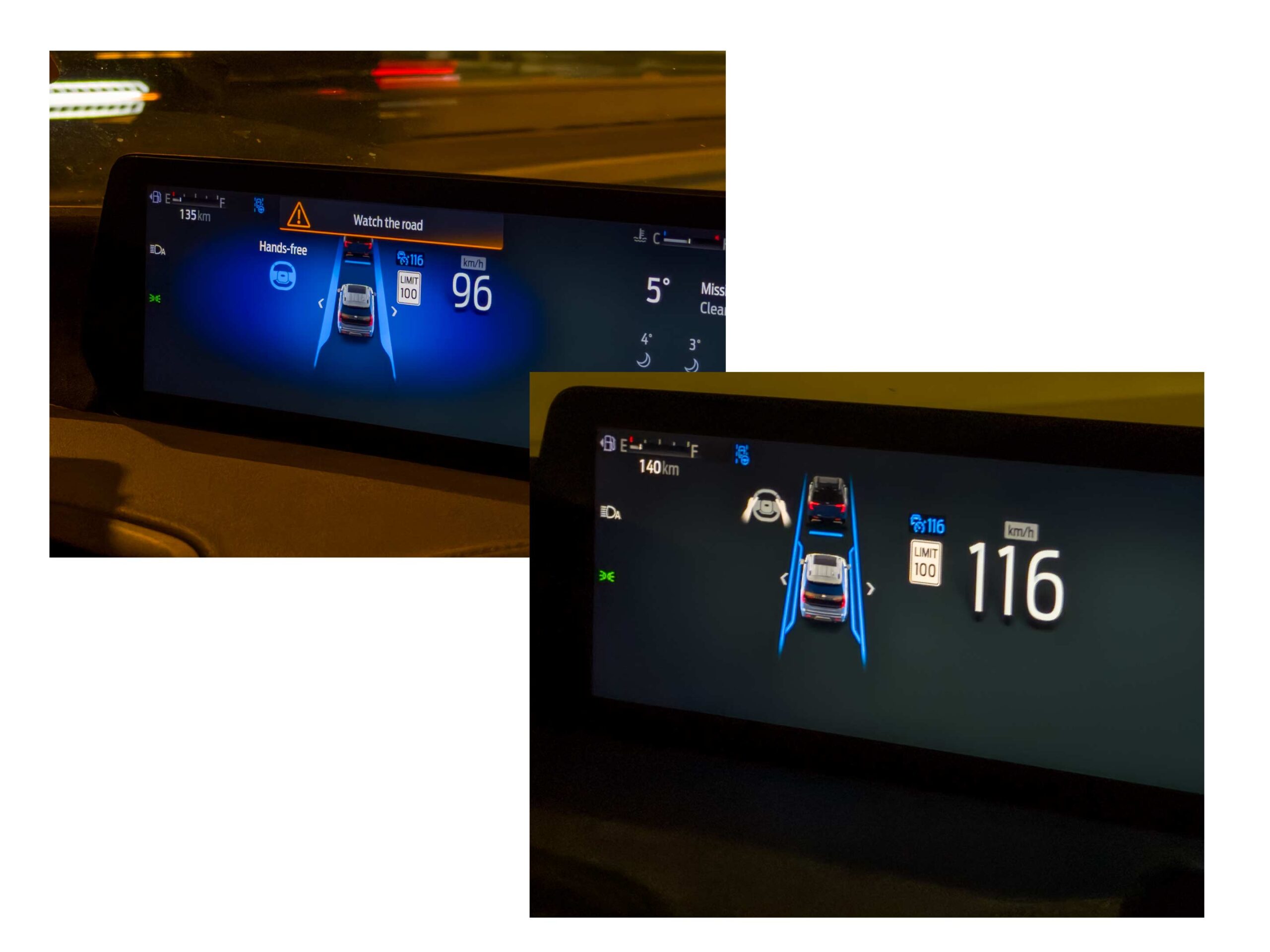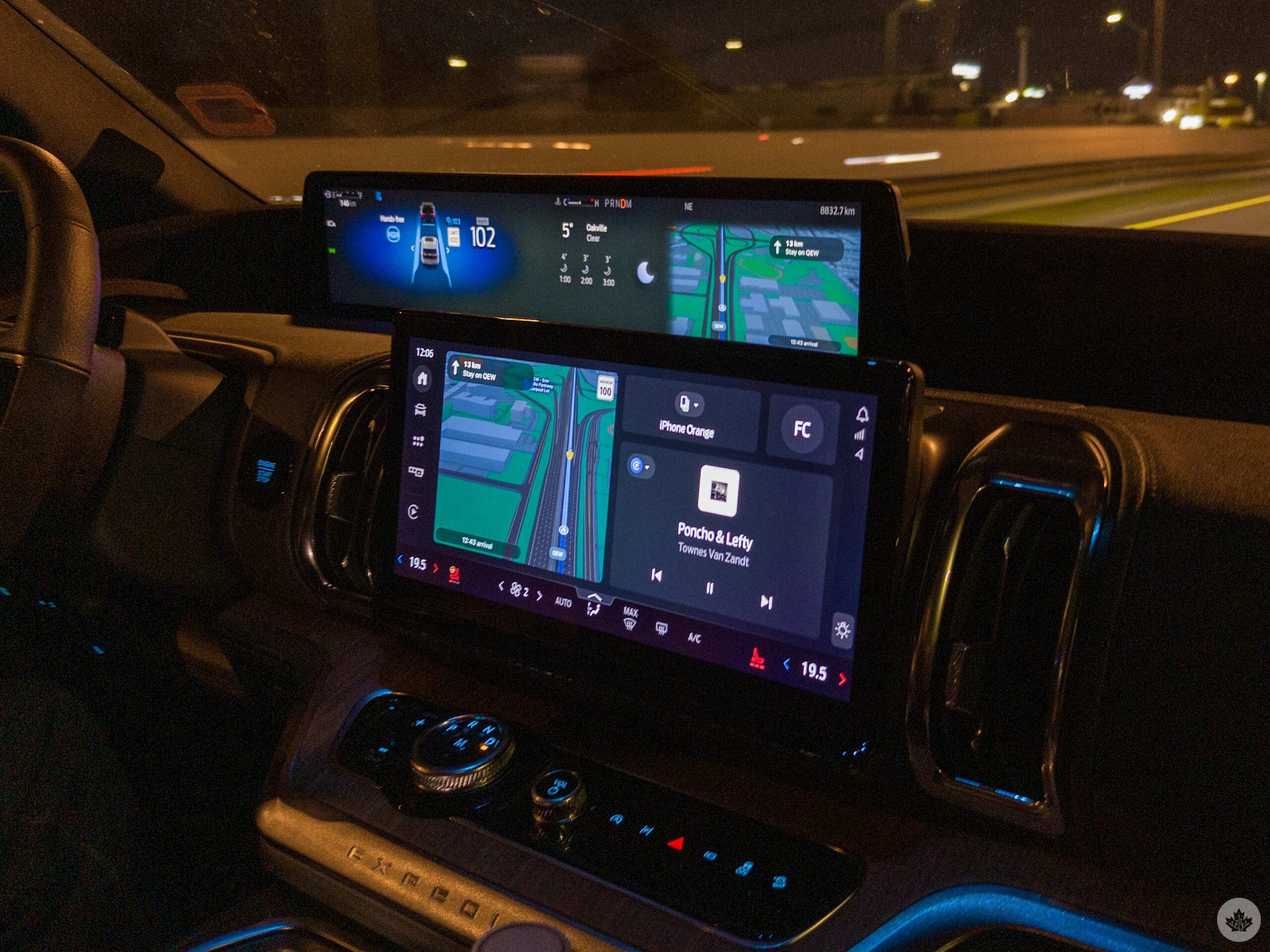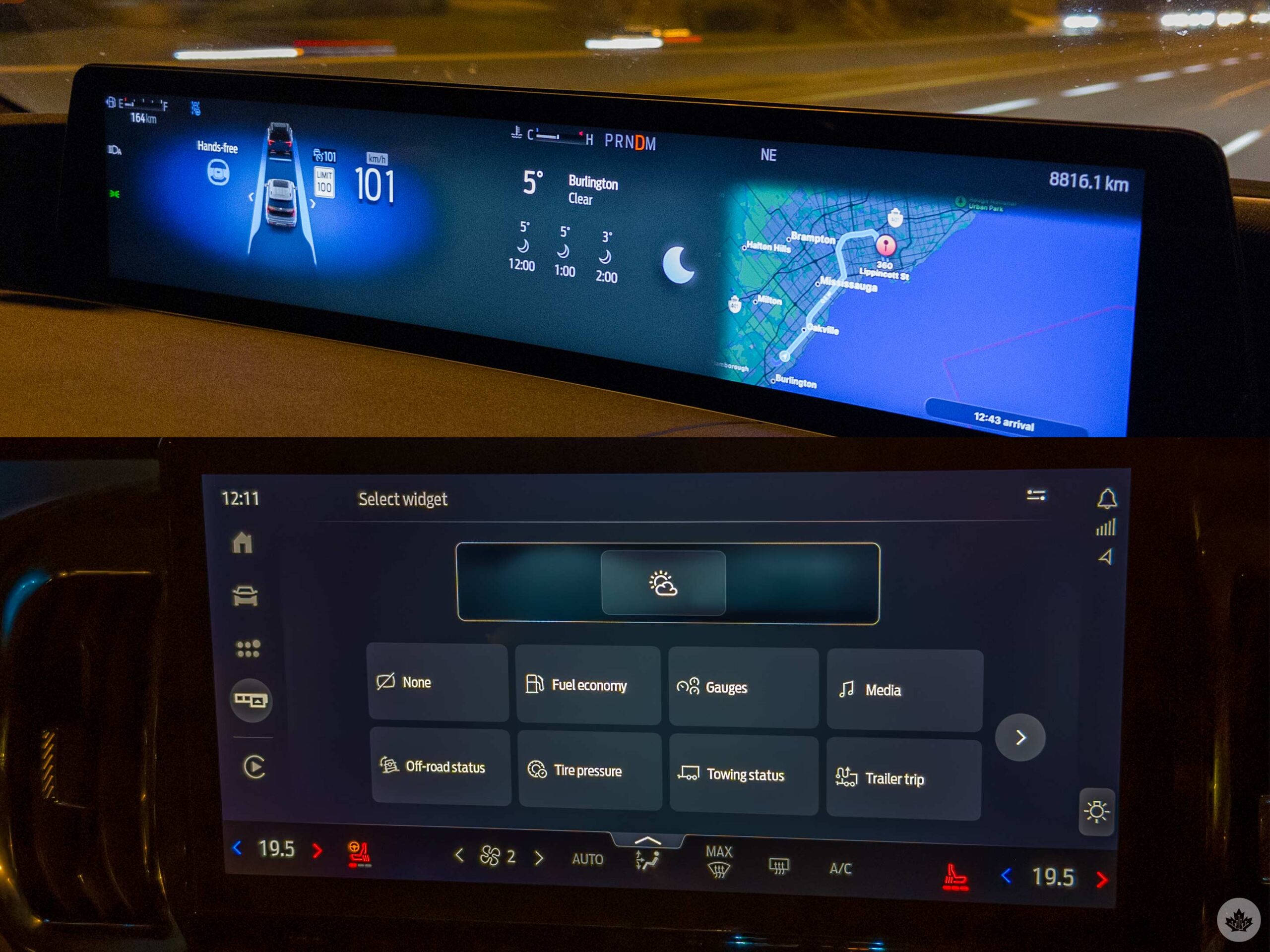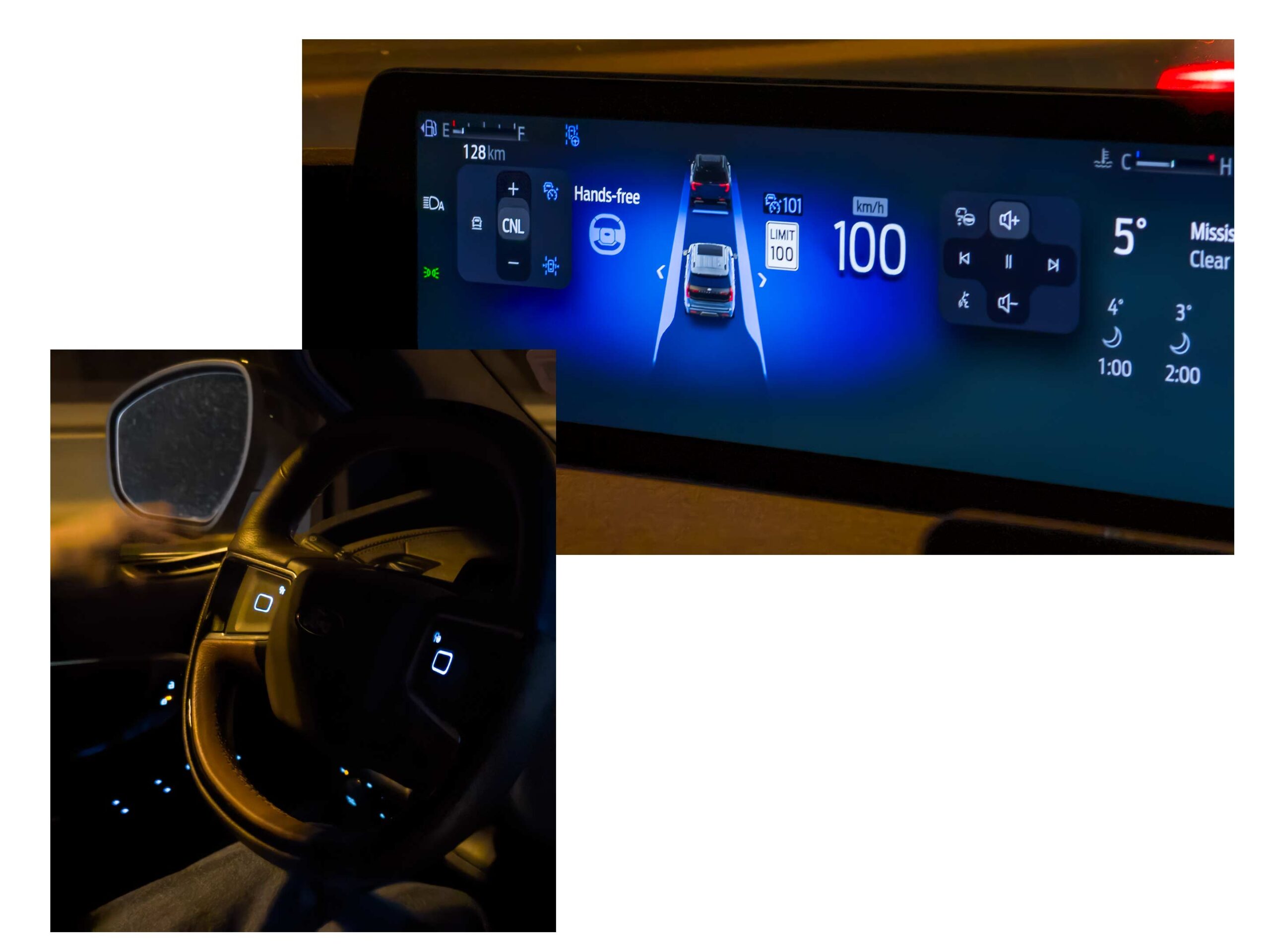Last year, I took GM’s Super Cruise for a test drive on a lengthy route from Toronto to Timmins, Ont., and back. This year, I followed the same route to put Ford’s Blue Cruise self-driving system to the test. I also did some local driving around the GTA, so altogether I spent close to 20 hours in the driver’s seat of the new Expedition. The SUV is fully loaded with Ford’s Blue Cruise and the company’s latest form of infotainment, both of which really impressed me.
Leaving my home downtown was fine, except for the issues with navigating and parking the giant Expedition in the city. Once I got onto the highway, I was able to turn on Blue Cruise, and the vehicle took over for a bit. The car remained in control for the most part until I reached the outskirts of the GTA, after which its hands-free driving implementation became less consistent.
Ford has two levels of its driver assistance. The first level requires the driver to have their hands on the wheel, and the second, Blue Cruise, allows you to take your hands off the wheel, and the car will drive itself on major highways.
The first level of the system is built into the car’s adaptive Cruise Control and is part of the Co-pilot 360 2.0 system. This works pretty well, but in my testing, it wasn’t as smart as you’d want it to be, often breaking later than a human would. It would also lurch forward much too fast if the cruise is set at, say, 100km/h and the person in front of me going 80km/h then moves out of the way. In these situations, the vehicle would jump forward with a little too much pep in its step. This is a great thing if you love engines and it proves that this big SUV is no slouch under the hood, but its driving style is more aggressive, and you need to learn to compensate for that when you’re behind the wheel.
When you switch to Blue Cruise, things are a little better, but many of the same issues persist. That said, for the most part, it works wonderfully, driving you around with ease. The main issue stems from how much you can actually use it in Canada. Ford hasn’t mapped that much road here, which means that I was only able to use the hands-free tech for about five hours of my 16-hour round trip to Timmins. This sounds great, but when compared to the competition, it falls quite far behind.
Ford’s mapped roads are on the left and GM’s are on the right.
This was strange to me because, to my understanding, there is a specific car with lots of sensors that Ford has used for mapping. Ford has mapped parts of the Trans-Canada Highway and Highway 11, but it’s unclear why there are so many gaps in the mapping. Worse, these gaps mean Blue Cruise turns on and off every few kilometres. Even on routes that are fully mapped on Ford’s website, the car would still click on and off with its self-driving. Twice, the car stopped self-driving, so I assumed it wouldn’t work on the road I was on; however, coming home on the same road, going the other direction, it worked. This happened both on my trip up north and while driving on a major highway around Toronto.
Another area where I would make an improvement is in the driver warning systems. When the car thinks you’re not paying attention, it will start to chime, cutting out your music until you re-focus on the road or put your hand on the wheel. This seems like a great idea, until it works too well.
For instance, in the Co-Pilot 360 mode, you need to keep a hand on the wheel at all times to prove that you’re able to take over. However, as you may know from driving on a highway before, there are long stretches that are straight, meaning that even though my hand is on the wheel, I’m not putting much pressure on it. The number of times this happened, and then the car would start beeping to interpret my music, was well over 20 on my long drive to Timmins. That might not sound like that much, but it gets annoying fast. When I tested out GM’s system, its first warning was to vibrate the seat a little bit, which felt like a much more elegant solution.

The top left image shows Blue Cruise enabled, plus the warning indicator. The lower image shows the Co-Pilot 360 interface.
The final thing that would be nice to tweak would be where the camera needs to be to watch the driver. In the model, I tested it was behind the steering wheel, which meant I couldn’t use my right arm to hold the top left corner of the wheel, a fairly common driving position on long drives when you need to switch up how you hold the wheel every hour or so. It appears that Ford has changed this in its F-150 trucks, but I haven’t tested that, so while it looks to be in a better spot, I can’t confirm if it’s better or worse.
Beyond all of that, when you can use it, Blue Cruise is worth having if you spend a lot of time driving major highways. Even if it’s not yet perfect, it stands to get a lot better as more roads are mapped. Plus, for a long drive like mine, even a couple of hours can really help fight against driving fatigue. You can buy it for seven years for $3,295, or you can pay $650 annually. If you just want it for a long road trip, it costs $65 per month.
Smart software design makes the car feel, well, smart…

While I may have left a little disappointed in the breadth of the self-driving systems, Ford gets a lot of things right when it comes to infotainment. Like many other automakers, it’s building on top of Android Automotive, but smartly, it’s not forcing its design language, meaning it coexists seamlessly alongside Android. It’s a really smart design path and moves Ford to the top of the pack when it comes to infotainment.
The other new item in this car is an enlarged and raised digital dashboard to make it easier to glance down at your speed, navigation and more without having to avert your eyes that far from the road. It’s a smart system for the driver, and I liked it a lot. That being said, I wish you could move the navigation area from the far right of the screen and more towards the centre. It’s part of the system I needed to use the most, and it felt weird having to move my eyes all the way past the local weather to also see when my turn was coming up.

You can customize this area a little bit, but it’s quite minimal and only allows you to swap out the weather for things like your tire pressure, now playing media and a few other things. A little more adaptability would be lovely here.
One area that was a little frustrating was the new touchpad controls on the steering wheel. Instead of having actual buttons, Ford has created two square touch pads with a button in the middle of each one. When you brush one with your finger, a menu opens up on the dashboard display showing you what each quadrant of the pad is acting as in that moment. The pads themselves are responsive, but I almost always had to look down at the screen longer than I wanted to as I navigated over to the button I wanted to hit.

The idea behind this is that the touchpads can adapt to be what you need, when you need it, but in my experience, the left one was always cruise control/self-driving related, and the right was mostly for media. I would have loved dedicated buttons here that I could learn to navigate with touch instead of needing to look at and navigate a menu every single time.
Beyond that, everything else was amazing. Even the virtual climate controls were well laid out and easy to adjust on the fly with large buttons. You can also ask Google to set the temperature, which still takes some getting used to, but if I owned a car with a virtual assistant, I would definitely start using it for temperature controls.

You can also use Google to send and receive texts hands-free, and the interface is consistently designed throughout. This even works with iPhones that are connected via Bluetooth. It’s a smart system, and when it’s combined with the app selection of Android Auto (mainly Spotify and Google Maps), it does a good job of making it so you don’t need to use a phone projection system like CarPlay or Android Auto. That said, Ford still allows you to use both, which is a great perk.
Overall, there’s a lot to like about this SUV on the tech side. It has a solid driver assistance/self-driving backbone, as well as top-end infotainment. While I wish the touchpads on the wheel were buttons, I think after using this car for a few weeks, I’d get better at using it. If you’re looking for a large SUV and the infotainment is your top focus, this is hard to beat. That said, from a driving and self-driving perspective, I enjoyed using the new Escalade earlier this year more.
MobileSyrup may earn a commission from purchases made via our links, which helps fund the journalism we provide free on our website. These links do not influence our editorial content. Support us here.
mobilesyrup.com (Article Sourced Website)
#Testing #Fords #modern #infotainment #Blue #Cruise #selfdriving
